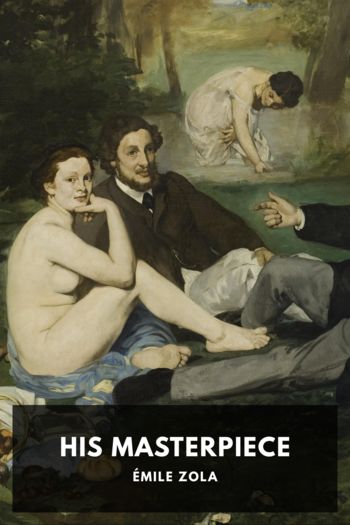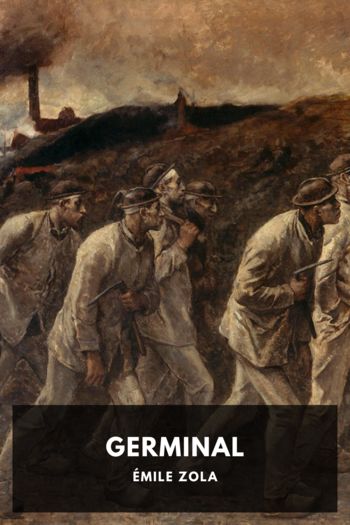His Masterpiece, Émile Zola [essential reading txt] 📗

- Author: Émile Zola
Book online «His Masterpiece, Émile Zola [essential reading txt] 📗». Author Émile Zola
But there was another cup of bitterness in reserve for Claude. On the left-hand panel, facing Fagerolles’, he perceived Bongrand’s picture. And in front of that painting there was no crush whatever; the visitors walked by with an air of indifference. Yet it was Bongrand’s supreme effort, the thrust he had been trying to give for years, a last work conceived in his obstinate craving to prove the virility of his decline. The hatred he harboured against the Village Wedding, that first masterpiece which had weighed upon all his toilsome afterlife, had impelled him to select a contrasting but corresponding subject: the Village Funeral—the funeral of a young girl, with relatives and friends straggling among fields of rye and oats. Bongrand had wrestled with himself, saying that people should see if he were done for, if the experience of his sixty years were not worth all the lucky dash of his youth; and now experience was defeated, the picture was destined to be a mournful failure, like the silent fall of an old man, which does not even stay passersby in their onward course. There were still some masterly bits, the choirboy holding the cross, the group of daughters of the Virgin carrying the bier, whose white dresses and ruddy flesh furnished a pretty contrast with the black Sunday toggery of the rustic mourners, among all the green stuff; only the priest in his alb, the girl carrying the Virgin’s banner, the family following the body, were drily handled; the whole picture, in fact, was displeasing in its very science and the obstinate stiffness of its treatment. One found in it a fatal, unconscious return to the troubled romanticism which had been the starting-point of the painter’s career. And the worst of the business was that there was justification for the indifference with which the public treated that art of another period, that cooked and somewhat dull style of painting, which no longer stopped one on one’s way, since great blazes of light had come into vogue.
It precisely happened that Bongrand entered the gallery with the hesitating step of a timid beginner, and Claude felt a pang at his heart as he saw him give a glance at his neglected picture and then another at Fagerolles’, which was bringing on a riot. At that moment the old painter must have been acutely conscious of his fall. If he had so far been devoured by the fear of slow decline, it was because he still doubted; and now he obtained sudden certainty; he was surviving his reputation, his talent was dead, he would never more give birth to living, palpitating works. He became very pale, and was about to turn and flee, when Chambouvard, the sculptor, entering the gallery by the other door, followed by his customary train of disciples, called to him without caring a fig for the people present:
“Ah! you humbug, I catch you at it—admiring yourself!”
He, Chambouvard, exhibited that year an execrable Reaping Woman, one of those stupidly spoilt figures which seemed like hoaxes on his part, so unworthy they were of his powerful hands; but he was none the less radiant, feeling certain that he had turned out yet another masterpiece, and promenading his godlike infallibility through the crowd which he did not hear laughing at him.
Bongrand did not answer, but looked at him with eyes scorched by fever.
“And my machine downstairs?” continued the sculptor. “Have you seen it? The little fellows of nowadays may try it on, but we are the only masters—we, old France!”
And thereupon he went off, followed by his court and bowing to the astonished public.
“The brute!” muttered Bongrand, suffocating with grief, as indignant as at the outburst of some lowbred fellow beside a deathbed.
He perceived Claude, and approached him. Was it not cowardly to flee from this gallery? And he determined to show his courage, his lofty soul, into which envy had never entered.
“Our friend Fagerolles has a success and no mistake,” he said. “I should be a hypocrite if I went into ecstasies over his picture, which I scarcely like; but he himself is really a very nice fellow indeed. Besides, you know how he exerted himself on your behalf.”
Claude was trying to find a word of admiration for the Village Funeral.
“The little cemetery in the background is so pretty!” he said at last. “Is it possible that the public—”
But Bongrand interrupted him in a rough voice:
“No compliments of condolence, my friend, eh? I see clear enough.”
At this moment somebody nodded to them in a familiar way, and Claude recognised Naudet—a Naudet who had grown and expanded, gilded by the success of his colossal strokes of business. Ambition was turning his head; he talked about sinking all the other picture dealers; he had built himself a palace, in which he posed as the king of the market, centralising masterpieces, and there opening large art shops of the modern style. One heard a jingle of millions on the very threshold of his hall; he held exhibitions there, even ran up other galleries elsewhere; and each time that May came round, he awaited the visits of the American amateurs whom he charged fifty thousand francs for a picture which he himself had purchased for ten thousand. Moreover, he lived in princely style, with a wife and children, a mistress, a country estate in Picardy, and extensive shooting grounds. His first large profits had come from the rise in value of works left by illustrious artists, now defunct, whose talent had been denied while they lived, such as Courbet, Millet, and Rousseau; and this had ended by making him disdain any picture signed





Comments (0)